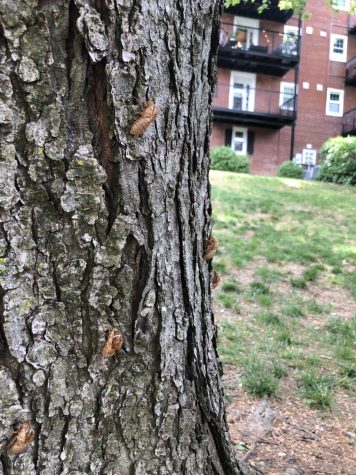Cicada Season!
The Brood X Cicadas return to the living.
The media is timid and interested for the cicadas arrival.

After staying hidden and feeding on underground tree sap for 17 years, the Brood X Cicadas have finally decided to make their appearance. This year, you will definitely know when they are coming, thanks to the loud buzzing noise cicadas give off. These insets are labeled with Roman Numerals. According to The Washington Post, the Cicadas arising this year are called the Brood X because they are the largest of all the Broods. If you are scared of normal looking cicadas, then you might need to tighten your hats… because Brood X is known for its bright, blood-like eyes.

This cicada cycle is a completely normal natural event and is proving that our nature is still balanced and intact which is a very good thing. These insects are beneficial to our environment as they aerate the soil and become part of the food chain. Although, these insects are not all sunshine’s and rainbows. Cicadas have been known to cause damage to some types of trees and according to IndyStar, if an animal stumbles across a cicada that has come in contact with insecticides, the animal may become poisoned. The balance of nature that occurs when the cicadas come to town can be worth the inconveniences.
This year, the cicadas will be emerging from the ground from many states. The states that will be getting the full Brood X experience include Virginia, North Carolina, Georgia, Kentucky, Tennessee, West Virginia, Maryland, Delaware, New Jersey, New York, Pennsylvania, Ohio, Illinois, Indiana, and Michigan. According to nj.com, temperatures have to reach at least 64 degrees before big hordes arise. The other states in the US are still going to run into the cicadas but these are going to be the main hatching grounds. These cicadas will start to make their peak in the early till the middle of June.
If you start to see weird dark looking things on the ground and accidental step on them, don’t be alarmed! This is not the cicada itself, just the outer shell of it. The outer shells are shed when the cicadas first come up from the ground. By this coming month, the ground will be swarming with cicada shells. There are many reasons for cicadas shedding their exoskeleton, but the main reason is simply to grow their hardened new adult cover.

The loud buzzing noise is their way of communicating and carrying out daily life. According to howstuffworks.com, the noise that cicadas make is produced by an organ called the tymbals which is located at the base of the abdomen. Most animals make noises that are unable to be heard by the human ear but unlike the others, cicadas stand out. The loudest noises can come out of the smallest beings. During a mid-summer day, these noisy insects are the most active while trying to keep the birds away with their songs. They stay in pacts and will also look for mates.
The last time that the Brood X cicadas came out was in 2007. These were only found in North America. Like this year’s brood, these cicadas were one of the largest insect outbreaks on earth. The Washington post says that scientists have come up with a theory that if the warm climate becomes a regular occurrence and global warming continues, then the cicada cycle will be disrupted, meaning that the 17-year cicadas, which include the brood x batch, would start becoming 13-year cicadas just like the rest. This is not the best boat for the 17-year cicadas to be in.

The next big hatch of cicadas will occur in 2038. While the 2021 Cicadas are out currently, they will prepare the surroundings for the ones that take their place in 17 years. The older cicadas will lay eggs above ground which will fall into the ground. This is where those baby cicadas will learn how to feed on the tree sap and all of the duties that are passed on from one generation to the next underground till it is time to come up again.




